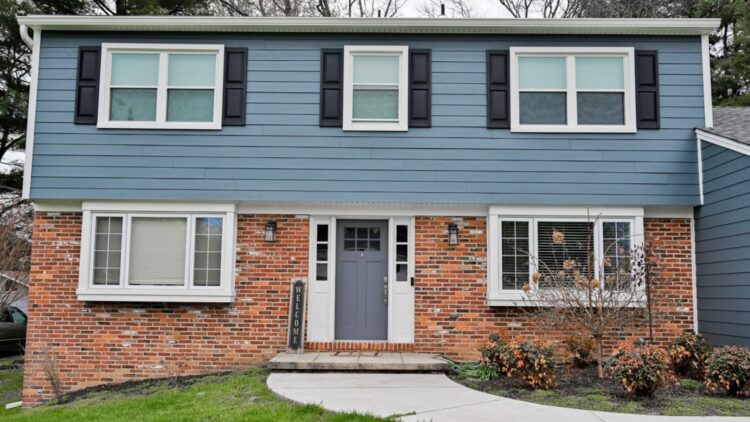
If your energy bills seem to spike every summer and winter, the issue might not be your HVAC system—it could be how your home manages heat.
Siding plays a bigger role than many homeowners realize. Everyone thinks about attic insulation, but rarely about all that wall surface area. In winter, a toboggan can help keep you warm, but you’re going to want to think about your coat too. In summer, some siding materials absorb heat from the sun, others reflect it, and some simply conduct it straight through into your home.
In other words, poor siding doesn’t just hurt your curb appeal—it actively participates in heat transfer, often in ways that work against you.
How Heat Moves—and What Siding Has to Do with It
When sunlight hits your home, the materials on the outside can:
- Absorb heat
- Reflect heat
- Conduct heat
Siding that conducts heat, like aluminum, does nothing to slow that transfer. Wrapping your house in aluminum is essentially like wrapping it in a coke can.
Vinyl and fiber cement absorb different amounts of heat, but both will pass it inward—warming your walls, raising your indoor temperature, and pushing your AC into overdrive.
But the long and short of it is that none of these siding options acts as an insulation. The only real solution to stopping thermal bridging is adding external insulation.
Smarter Siding Solutions for Homeowners
In regions like Fairfax County, VA and Montgomery County, MD, homeowners experience a true four-season climate—hot, humid summers; cold, sometimes snowy winters; and unpredictable swings in between. That means your siding needs to be more than just a pretty face—it has to perform year-round.
Older homes often still have their original siding, which wasn’t designed for modern energy efficiency. Aging vinyl may be faded, cracked, or warped, leaving gaps for heat and moisture. Combine that with poorly insulated wall cavities, thermally bridging studs, and a lack of air or vapor barriers, and you have a recipe for high energy bills.
Homes in this area benefit from siding that can handle thermal swings, resist moisture, and maintain its structural integrity no matter what the forecast looks like. Otherwise, you’re not just dealing with higher costs—you’re also facing reduced comfort and potentially costly repairs down the line.
A Closer Look at Heat-Reflective, Durable Siding Options
At Presidential Exteriors, we recommend two systems that wrap your home in a “warm blanket” rather than a thin metal or plastic coat.
System 1: Fullback Insulated Mastic Quest & Structure
Installing insulated vinyl siding is substantially more work and requires more materials than most people expect. While standard vinyl is light and relatively easy to work with, insulated vinyl demands:
- More precise detailing
- Additional accessories
- Complex flashing and trimming techniques
The difference between a rookie installation and a professional one often comes down to proper flashing and trim work. With insulated vinyl, flashing becomes more intricate and involved, often requiring:
- Custom metal depths
- Z-flashings
- Specialized starter strips
- Unique coverings for a seamless, weather-tight fit
Progressive Foam’s Fullback® insulation offers R-values greater than 4. When combined with a fully sealed Tyvek® wind barrier and a premium-thickness Mastic panel, you can often improve your wall system’s energy efficiency by more than 30%.
System 2: James Hardie Fiber Cement with Thermal Backing
James Hardie siding is known for its durability and ability to withstand heat, moisture, pests, and severe weather, making it a great choice for almost any home in our region.
While heavier and more substantial than vinyl, Hardie doesn’t add much thermal resistance on its own. That’s why we install it with a full thermal sheet backing to:
- Stop thermal bridging
- Add additional R-value to the exterior
- Improve comfort in all seasons
Like insulated vinyl, installing Hardie with added backing can be trickier, especially on older homes with specific architectural details or limitations. But with thousands of installations completed, we know how to adapt the system to your home’s needs.
Hardie also features ColorPlus® Technology, which:
- Resists fading
- Reflects more sunlight than standard finishes
- Reduces surface heat
- Cuts down on repainting needs
Should You Consider Replacing Your Siding?
Ask yourself:
- Is my home too hot in summer or too cold in winter despite a working HVAC system?
- Are my energy bills higher than my neighbors’?
- Is my siding cracked, warped, faded, or hot to the touch?
- Does it fade easily or feel hot to the touch on sunny days?
If you answered yes to any of those, it might be time to evaluate your siding’s energy performance. When considering new siding, look for materials that are proven to perform well in both hot and cold conditions. Check energy efficiency ratings, ask about warranties, and make sure the product is suited to Mid-Atlantic weather.
Your siding should be more than just a design choice—it’s an energy decision. Want to know if your siding is costing you more than it should? Get a free estimate and explore siding options designed to keep your home efficient, comfortable, and weather-ready.